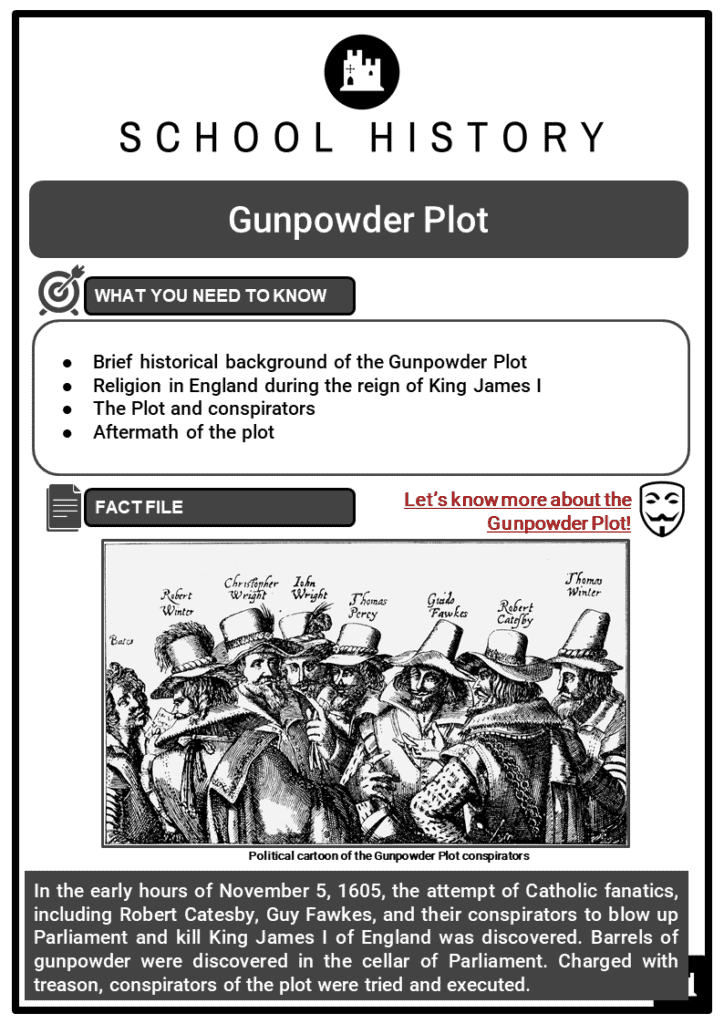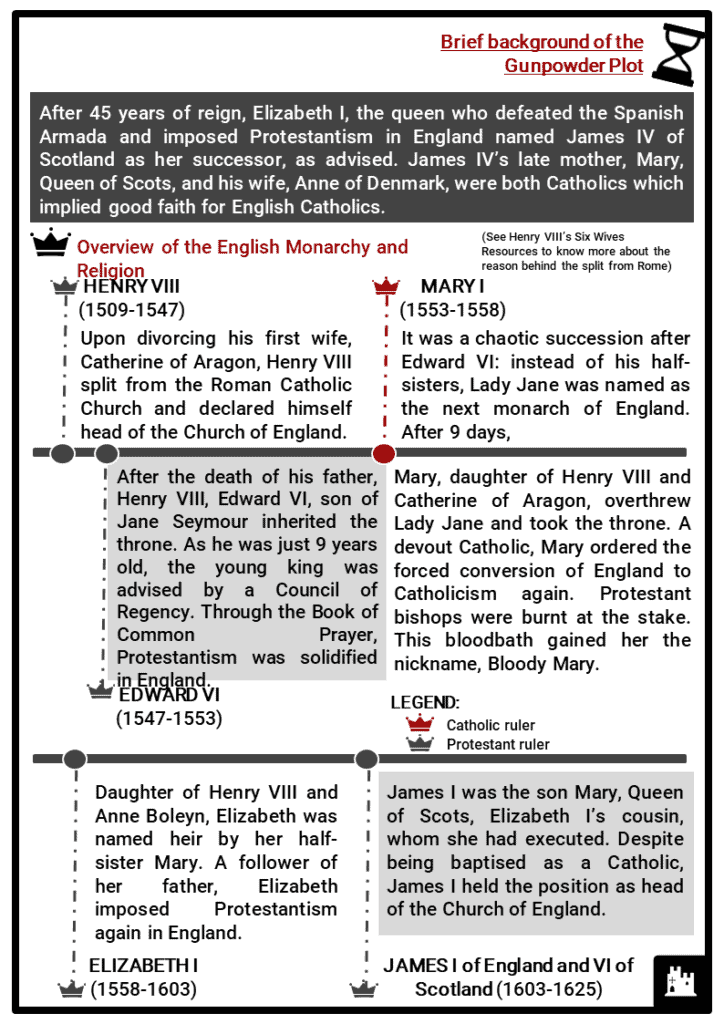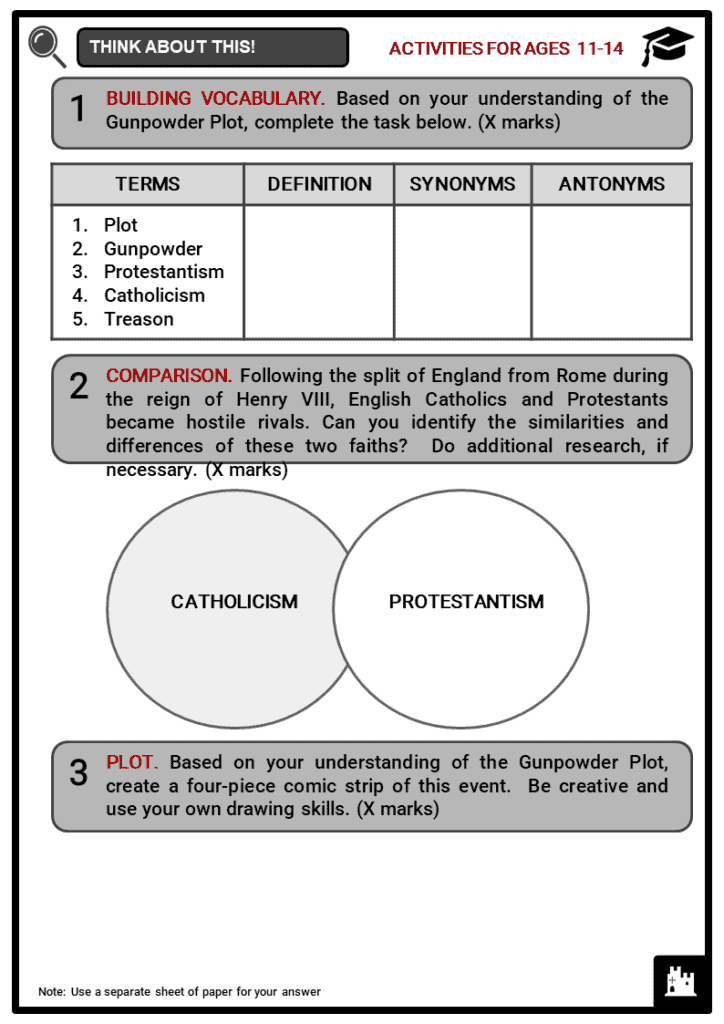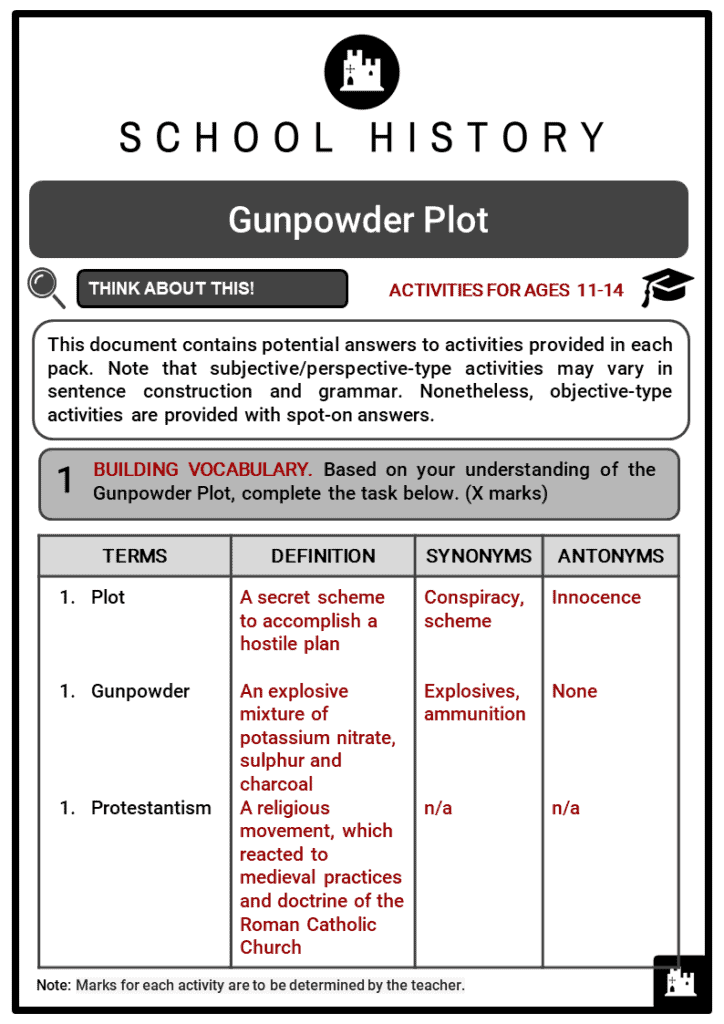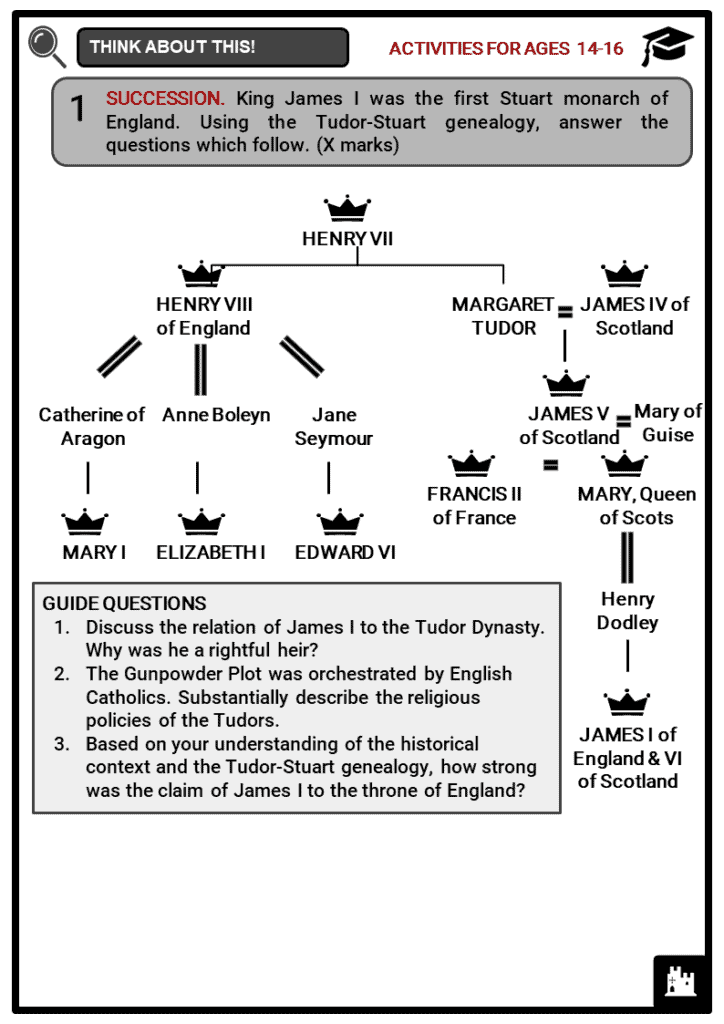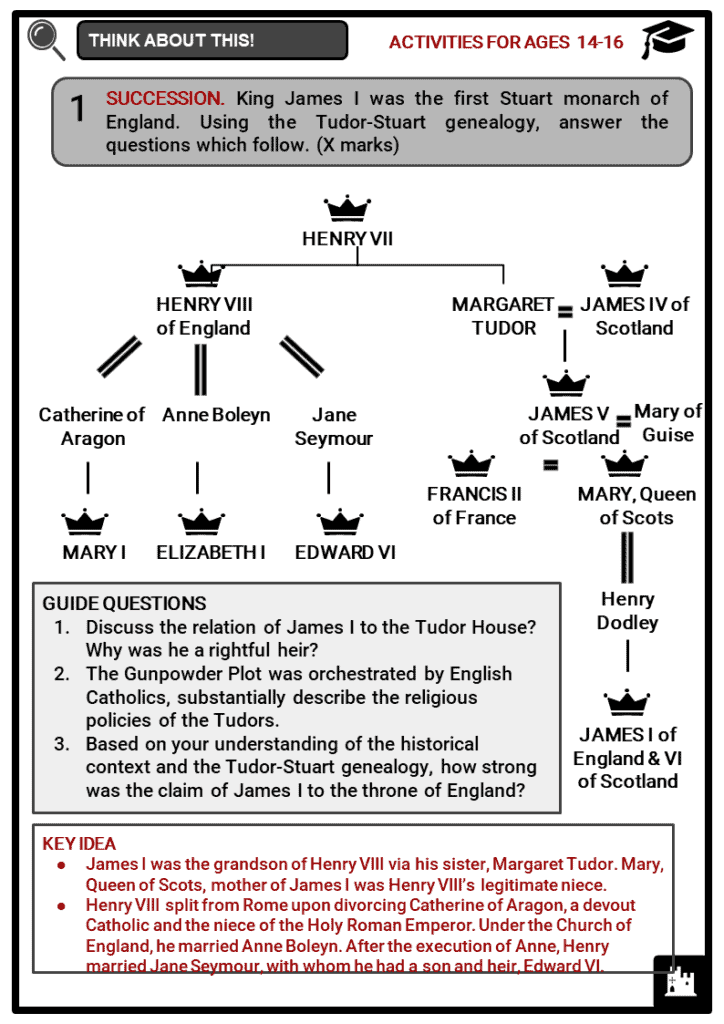Download Gunpowder Plot Worksheets
Do you want to save dozens of hours in time? Get your evenings and weekends back? Be able to teach Gunpowder Plot to your students?
Our worksheet bundle includes a fact file and printable worksheets and student activities. Perfect for both the classroom and homeschooling!
Table of Contents
Add a header to begin generating the table of contents
Summary
- Brief historical background of the Gunpowder Plot
- Religion in England during the reign of King James I
- The Plot and conspirators
- Aftermath of the plot
Key Facts And Information
Let’s know more about the Gunpowder Plot!
- In the early hours of November 5, 1605, the attempt of Catholic fanatics, including Robert Catesby, Guy Fawkes, and their conspirators to blow up Parliament and kill King James I of England was discovered. Barrels of gunpowder were discovered in the cellar of Parliament. Charged with treason, conspirators of the plot were tried and executed.
Brief background of the Gunpowder Plot
- After 45 years of reign, Elizabeth I, the queen who defeated the Spanish Armada and imposed Protestantism in England named James IV of Scotland as her successor, as advised. James IV’s late mother, Mary, Queen of Scots, and his wife, Anne of Denmark, were both Catholics which implied good faith for English Catholics.
Overview of the English Monarchy and Religion
- HENRY VIII (1509-1547)
- Upon divorcing his first wife, Catherine of Aragon, Henry VIII split from the Roman Catholic Church and declared himself head of the Church of England.
- MARY I (1553-1558)
- It was a chaotic succession after Edward VI: instead of his half-sisters, Lady Jane was named as the next monarch of England. After 9 days, Mary, daughter of Henry VIII and Catherine of Aragon, overthrew Lady Jane and took the throne. A devout Catholic, Mary ordered the forced conversion of England to Catholicism again. Protestant bishops were burnt at the stake. This bloodbath gained her the nickname, Bloody Mary.
- EDWARD VI (1547-1553)
- After the death of his father, Henry VIII, Edward VI, son of Jane Seymour inherited the throne. As he was just 9 years old, the young king was advised by a Council of Regency. Through the Book of Common Prayer, Protestantism was solidified in England.
- ELIZABETH I (1558-1603)
- Daughter of Henry VIII and Anne Boleyn, Elizabeth was named heir by her half-sister Mary. A follower of her father, Elizabeth imposed Protestantism again in England.
- JAMES I of England and VI of Scotland (1603-1625)
- James I was the son Mary, Queen of Scots, Elizabeth I’s cousin, whom she had executed. Despite being baptised as a Catholic, James I held the position as head of the Church of England.
- After an era of Catholic persecution in England, many expected James I to be more tolerant of English Catholics. Another factor of disillusionment amongst English Catholics was the treaty signed at the Somerset House Conference in 1604 which concluded the long years of war between Spain and England (since Elizabeth I of England and Philip II of Spain were both dead).
- When James I ascended the throne, majority of the House of Commons were anti-Catholic. Early in 1603, many Catholics had been unimpressed with the king’s measures on religious tolerance.
- Prior to James I’s succession to the throne of England, some exiled Catholics planned to put Isabella, daughter of Philip II of Spain, on the throne as the rightful queen, while others viewed Arbella Stuart, Elizabeth I’s cousin as the rightful monarch..
- During the reign of Elizabeth I in the late 16th century, Catholics failed in their attempts to assassinate the Queen.
- James I was no different. The first attempt to kidnap the king was planned by William Watson and William Clark. The plan was to kidnap the king and imprison him in the Tower of London until he agreed to pursue tolerance towards English Catholics.
- At the same time, the Main Plot was made by Lord Cobham, Lord Grey de Wilton, Griffin Markham, and Walter Raleigh to overthrow the king and his family and be replaced by Arbella Stuart.
- Conspirators in the Bye and Main Plots were either executed, pardoned, or fined. In February 1604, James I discovered that his wife received a rosary from the Pope. Because of this, the king denounced the Catholic Church.
- After three days, he ordered the expulsion of all Catholic priests, especially the Jesuits. James I further angered English Catholics when he appointed Scottish nobles in Parliament.
- Catholic nobles who refused to attend church services were fined monthly. On March 19, 1604, he delivered a speech to Parliament that his desired peace and this could only be achieved through the profession of the true religion. For the Catholics, this cemented their anti-Church of England position.
The Gunpowder Plot
- The conspirators of the Gunpowder Plot did not only aim to kill the king, but also the members of the Privy Council. This included Protestant aristocracy and bishops of the Church of England.
- Moreover, they also planned to kidnap Elizabeth, James I’s daughter, and install her as the Queen of England after the death of her father and members of Parliament.
- The mastermind of the plot was Robert Catesby, who organised a Spanish-funded mission to invade England in 1603.
- On May 20, 1604, the first meeting of conspirators namely, Robert Catesby, Guy Fawkes, Thomas Wintour, John Wright, and Thomas Percy took place at the Duck and Drake Inn. They swore an oath of secrecy and received a Eucharist in a mass officiated by Father John Gerard.
- In the following months, they were able to recruit more Catholic nobles. In October 1604, Robert Keyes took charge of storing the gunpowder and other supplies at Catesby’s house in Lambeth.
- In December, the opening of Parliament was delayed due to the plague, and so the plotters moved their plan.
- According to Guy Fawkes’ testimony, 36 barrels of gunpowder were place in the cellar of the House of Parliament in July 1605. By late August, more gunpowder was brought in, which was concealed with firewood.
- Hours before the attack, Lord Monteagle, brother-in-law of one of the conspirators, warned the government about the plot after receiving an anonymous letter urging him not to attend the meeting. At midnight of November 5, 1605, barrels of gunpowder were discovered in the cellar, along with Guy Fawkes.
Who was Guy Fawkes?
- Born in York in 1570, Guy Fawkes was a convert to the Catholic faith. He fought for Catholic Spain against the Protestant Dutch reformers in his early years.
- After his failed attempt to seek Spanish support for a Catholic rebellion in England, Fawkes met Thomas Wintour and Robert Catesby, who were planning the Gunpowder Plot.
- After his arrest and torture, Fawkes revealed his co-conspirators. In the following weeks, all were tried and executed for high treason.
- On January 31, 1606, hours before his execution, Fawkes climb a ladder to the gallows and committed suicide.
Other Major Conspirators
- ROBERT CATESBY
- Son of Sir William Catesby, Robert was grew in hatred towards the Church of England after witnessing the persecution of his father during the reign of Queen Elizabeth I.
- In 1601, Robert promoted the Spanish invasion of England. This failed plan was backed up with his 1603 plan of destroying Parliament and killing King James I through the Gunpowder Plot.
- As chief instigator of the plot, Catesby assembled other conspirators. His house also became the storage place for gunpowder barrels before being smuggled into Parliament.
- After the discovery of the plot, Catesby was killed in Staffordshire.
- THOMAS PERCY
- Thomas Percy was the cousin of Henry Percy, 9th earl of Northumberland, and a co-conspirator.
- Percy was the one who rented a house near Westminster, which they used to initially dig a tunnel towards the palace.
- He also rented a cellar below the Lords’ chamber where the barrels of gunpowder were discovered.
- Along with Catesby, Percy was killed on November 8, 1605.
- Other major conspirators, according to Guy Fawkes, included Thomas Wintour, Father Henry Garnet, William Parker, Baron Monteagle, Sir Walter Raleigh, Robert Cecil, and Sir Edward Coke.
Aftermath of the plot
- Conspirators of the Gunpowder Plot were hanged and mutilated to serve as an example for Catholics who wanted to stage another plot against King James I. Here are some of the consequences of the last Catholic plot in England:
- Many Catholic lords who were related to the conspirators were either arrested, executed, or fined heavily.
- Through the Popish Recusants Act, Catholics were forced to take an oath of allegiance to the Crown. It also increased their fines.
- In 1605, Parliament passed the Observance of 5th November Act, also known as the Thanksgiving Act,to commemorate the event. Today, children make an effigy of Guy Fawkes and burn it on a bonfire. Fireworks are also let off.
- Catholics in England and Scotland lived uncomfortably, though some loyal Catholic lords remained in high positions throughout James I’s reign.
Conspiracy theories
- Some historians suggest that the Gunpowder Plot was part of a government conspiracy. Few believed that this dramatic plot, which became one of the best known events in British history was actually staged. Here are some conspiracy theories about this event.
- During this time, gunpowder was monopolised by the government, so how did the conspirators acquire a lot of it? Moreover, it was difficult for them to smuggle 36 barrels to the Parliament building.
- Others argued that the plotters may have acquired the gunpowder on the black market or through Catholic France.
- Ringleaders, Percy and Catesby were killed outright, unlike others who were arrested and interrogated. They may have been killed outright because it was possible that they fought with their pursuers.
- The tunnel, which was supposedly used by the conspirators, was never found below Parliament.
- Several suspected plotters were captured even before they were ratted out by Fawkes.
- Some view that the authorship of the letter Monteagle received from Francis Tresham was questionable. Moreover, suspicion also arose as Monteagle’s servant read the letter aloud.
- The death of Francis Treshman through poison, while locked in the Tower of London also caused suspicion.

